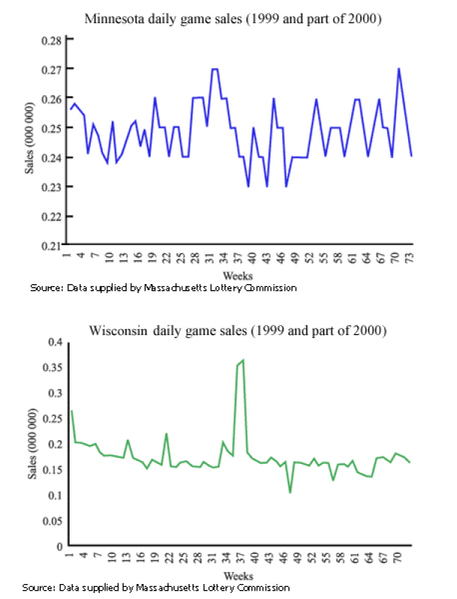The WAGER, Vol. 6 (36) – Warnings V. Winnings: Do Labels Change Gambling Patterns?
Although warning labels were initially met with much resistance by the alcohol and tobacco industries, research has found their influence to be dubious at best (e.g., MacKinnon, Nohre, Pentz, & Stacy, 2000; McGowan, 2001; Robinson & Killen, 1997). Like these businesses, the gambling industry has resisted the addition of warning labels on its venues (McGowan, 2001). However, what is the effect of warning labels on gaming? In the course of providing an interesting look at the role of the government in the evolution of the gambling industry in the United States, a newly published book by Richard McGowan, "Government and the Transformation of the Gaming Industry," addresses this issue.1 This WAGER reports on McGowan’s findings concerning the use of warning labels at gambling venues and their effects on lottery sales.
To determine the effect of having warning labels or not, McGowan compared newly introduced lotteries in Minnesota (launched in 1990) and Wisconsin (started in 1988). McGowan reported that the only significant difference between the states in the development of their lotteries was that Minnesota required warning labels and Wisconsin did not. Thus, any differences in sales would be due primarily to having labels versus not having labels. A comparison of the product life cycles2 revealed that the patterns for both states, as measured by polynomial regressions of sales on time, were similar:
Minnesota (Daily Game sales = 0.0226x – 0.0006×2 – 0.00004×3, F=424.11 p=0.000, R2=0.942)
Wisconsin (Daily Game sales = 0.0174x – 0.0005×2 – 0.00003×3, F=266.09 p=0.000, R2=0.884).
McGowan concluded that warning labels had little, if any, effect on lottery sales. In both states, sales were unchanged over time. The figures below plot the total weekly sales for approximately the first year and a half of operation.
McGowan’s book concentrated on the economic effects of gambling. Except for one major non-economic effect (i.e., legal ramifications), McGowan did not examine the social changes that could stem from the addition of warning labels. For example, labels might stimulate help seeking among problem gamblers. Alternatively, warning labels might stimulate gambling among some populations. Research on tobacco warning labels has found that greater knowledge of warning labels is associated with increases in rates of smoking among adolescents (Robinson & Killen, 1997).3 The social effects of warning labels deserves more study. McGowan’s book does an excellent job of highlighting the many important influences of government on gambling economics. As local, state, and federal governments become increasingly involved in both establishing gambling opportunities and regulating gambling, a better understanding of how government can influence gambling behavior becomes increasingly important.
1 For the past two years Richard McGowan, S. J. has been a visiting faculty member at the Division on Addictions. We are extremely glad to have him as a colleague and equally fortunate to be able to share some of his work in the WAGER.
2 "The product life cycle is a marketing concept that identifies four discrete stages that mark the evolution of a product such as the lottery," (McGowan, 2001). The four stages identified in McGowan (2001) are: (1) introduction, (2) growth, (3) maturation, & (4) decline.
3 Consistent with this finding, informal investigation of daily lottery game sales suggests that sales in Minnesota are slightly higher than in Wisconsin. Thus, the state with warning labels seems to sell more daily lottery game tickets than the state without warning labels. Further, a comparison of New Mexico and Arizona found that New Mexico, a state without warning labels, failed to effectively establish a daily lottery game after an initial attempt and subsequently focused on instant and lotto games while Arizona’s daily lottery was
successful despite the use of warning labels (McGowan, 2001).
References
MacKinnon, D. P., Nohre, L., Pentz, M., & Stacy, A. W. (2000). The alcohol warning and adolescents: 5 year effect. American Journal of Public Health, 90(10), 1589-1294.
McGowan, R. A. (2001). Government and the Transformation of the Gaming Industry. Northampton, MA: Edward Elgar Publishing, Inc.
Robinson, T. N. & Killen, J. D. (1997). Do cigarette warning labels reduce smoking? Paradoxical effects among adolescents. Archives of Pediatric & Adolescent Medicine, 151(3), 267-272.
The WAGER is a public education project of the Division on Addictions at Harvard Medical
School. It is funded, in part, by the National Center for Responsible Gaming, the
Massachusetts Department of Public Health, the Addiction Technology Transfer Center of
New England, the Substance Abuse and Mental Health Services Administration, and the
Center for Substance Abuse Treatment.
